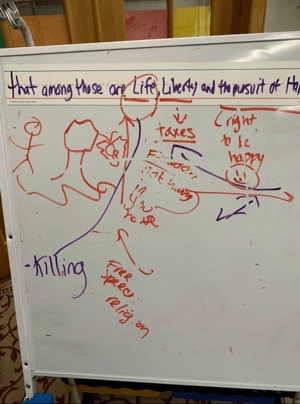 Pictured here is what remains of a language dive that fourth grade students (who are now fifth graders) and I completed on March 13, 2020 as they were studying the Declaration of independence and American Revolution. This document was critical to understanding Module 3 of the 4th grade EL Education ELA curriculum.
Pictured here is what remains of a language dive that fourth grade students (who are now fifth graders) and I completed on March 13, 2020 as they were studying the Declaration of independence and American Revolution. This document was critical to understanding Module 3 of the 4th grade EL Education ELA curriculum.
I found this language dive on a board when I returned to my Multilingual Learning Office days after the death of George Floyd had shaken the nation. It was the first time in a long time that I had sat in that room alone. I cried. I cried because I missed my crew and that was one of the last in-person discussions we had before the COVID-19 pandemic forced school closures in the 2019-20 school year.
The conversation surrounding this dive was about the fact that we knew that the Declaration of Independence was not originally written for everyone. The discussion surrounding our dives in deconstructing the meaning of the text transcended into students drawing the conclusion on their own that these rights intended for our country were solely written for men who were wealthy and not of color. They talked with sadness and tried to make sense of what it meant to be “happy and free.” We also talked about values and beliefs—and the importance of standing up for them.
Whether our learning setting is remote, in person or a hybrid, it’s difficult for us to avoid conversation about the medical pandemic that has, in recent time, stopped the world or the racial pandemic that is plaguing us in this country. Navigating these times is difficult, but it is important to be cognizant of the fact that our students have spent the summer watching images of the death of George Floyd and other men and women of color, seeing protests on television, and having protests in their own communities. Our students have a lot on their minds when it comes to social justice and equity. As educators, we need to give them the platform to discuss race in America. We need our curricula to have the resources that support these discussions.
As an Open Up Resources Community Coach, I have conversations with teachers all over the country about the EL Education K-8 ELA Curriculum in the Open Up Resources EL Education Facebook Group. Yes, we have discussions about navigating the books, anchor charts, and Skills block rotations. We also prioritize supporting students' literacy growth and about teaching our students what it means to be ethical people striving for a better world. The resources are a gateway to support us, but we, as educators, also have to think about who we are and identify our own world views prior to discussing the topics of race and equity with our classrooms.
In this racial pandemic, we have to offer students safe spaces to have discussions about their feelings and fears. We have to give them the space to make connections in understanding how historical documents were not always in favor of people of color, and they have to now pave the way for themselves and peers within their communities to have equitable resources and chances for achievement and success.
Those conversations in your classrooms will need to be brave and courageous. We have spent enough time tip-toeing around the fragility of people who are not of color in order to not “offend” anyone. Though conversations on racial justice make some of the adults and policy makers uncomfortable, in order to see the change and make it, we must agree that discomfort is a path to growth. If we are going to stand by teaching children to be “ethical people” and strive for a better world, then we need to do that whole heartedly. There is nothing wrong with advocating that Black Lives Matter in your classroom and taking an anti-racist stance—it serves for better world learning.
During these times, lend an ear and care about what students say to you. Also let students know that you think they matter in this world and that you will be their co-conspirator in standing up for racial and social justice.
Let the conversations happen this year, you never know where they will take you, your students and their communities.
For more resources on creating an anti-racist classroom and more equitable schools, click here.
Sarah Said is  the Director of Language and Equity Programs at an EL Education School in the Chicago Suburbs. In her role, she oversees support programs for Multilingual Learners, works with others to create a community that fosters success for students from the diverse communities her school serves, helps strengthen school to community outreach, and coordinates Title grants. In the past, she has been a Director of ELL, Dean and Curriculum Coordinator. In addition to her role in her building, she is a contributor for ELL Confianza and has written a variety of blog posts online. She is a member of the #ELLChat and #ELLchat_bkClub where she helps advocate for Multilingual Learners. Follow her on twitter: @MrsSaid17
the Director of Language and Equity Programs at an EL Education School in the Chicago Suburbs. In her role, she oversees support programs for Multilingual Learners, works with others to create a community that fosters success for students from the diverse communities her school serves, helps strengthen school to community outreach, and coordinates Title grants. In the past, she has been a Director of ELL, Dean and Curriculum Coordinator. In addition to her role in her building, she is a contributor for ELL Confianza and has written a variety of blog posts online. She is a member of the #ELLChat and #ELLchat_bkClub where she helps advocate for Multilingual Learners. Follow her on twitter: @MrsSaid17

